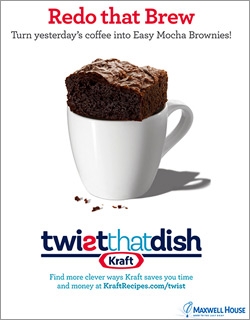food
Kraft Rolls Out Recipe Hub, Content Marketing Program For 'Strapped' Consumers
- by Karlene Lukovitz @KLmarketdaily, March 10, 2015
 Kraft
Foods is rolling out "Twist That Dish," a new content marketing program designed primarily to help budget-conscious consumers save money and time, while creating meals that please their families.
Kraft
Foods is rolling out "Twist That Dish," a new content marketing program designed primarily to help budget-conscious consumers save money and time, while creating meals that please their families.
Budget-conscious — or what Kraft calls "strapped" — consumers, along with Hispanics and Millennials, are the major focuses of Kraft's overall marketing strategy. And while the three groups have "a ton of overlap," there are also many segment-specific attitudes and behaviors, notes Ryan Galili, a senior brand manager at Kraft, focusing on brand strategy.
The new program's core is a more targeted Twist That Dish sub-hub (with both English-and Spanish site versions) that has been added to the company's longstanding, cross-brands recipe hubs, KraftRecipes.com and sister Spanish-language destination ComidaKraft.com. Those broader recipe destinations currently boast more than 60,000 recipes (half of them consumer-generated) and 1 billion recipe views per year.
advertisement
advertisement
The Twist site and supporting elements were developed as a result of insights that were drawn from Kraft's data (including users of KraftRecipes.com and the 1 million paid subscribers to its 19-year-old magazine, Food & Family), plus social listening and the company's in-home pantry studies.
The first insight about moms and other strapped consumers is that they take pride in being good cooks and stretching their limited budgets, without sacrificing taste or nutrition. "Also, as the month progresses and money gets tighter, they get increasingly creative about using ingredients and food hacks, or what we call 'twists,'" Galili tells Marketing Daily.
They're also digitally savvy, and love to share their recipes and ingenious hacks. And that's not just the budget-strapped Millennials, by any means. In fact, "it's particularly true for Hispanic moms, who believe that they invented food hacks, which they call 'inventos caseros'," reports Galili.
The result of the insights is the Twist hub, which launched last month with more than 150 fast, budget-friendly food hacks intended to offer solutions for every occasion. But those recipes are just the beginning.
"The beauty of the Twist That Dish program is that it leverages the hacks trend, the expertise of our Kraft Kitchen staff, our strengths as a content provider, and — like KraftRecipes.com — it creates a self-sufficient ecosystem," says Galili. "We put out content, it inspires consumers, and they share back with their own recipes and twists."
Kraft encourages that cycle by including a variety of sharing options on each recipe (buttons for Facebook, Twitter, Google+, Pinterest and email). It's also employing usage data to optimize the site in real time, including featuring the most popular hacks prominently and putting them in rotation.
In addition, for the launch, Kraft is running a "share and win" sweepstakes, in which consumers who submit their own favorite twists, with a description or photo, on the Twist site or through Twitter or Instagram (using #KraftTwistsSweeps) earn chances to win a grand prize of $10,000 toward a kitchen makeover and daily kitchen/cooking prizes. Participants are, of course, also being encouraged to share their entries on social with friends and family. (To enter, they must already be "members" of the Kraft hub, or register with their emails to opt in.)
The sweeps has generated more than 8,000 entries in about two weeks. But because Kraft's main goal "is to drive people to the hub so that they can judge the content for themselves," other, non-contest efforts being used for that purpose are considered equally or more important, says Galili.
For example, 6- and 15-second videos created by the Tongal agency — fast, fun takes on the making of some the most popular twists, backed by energetic music — promote the hub link, and are being featured on Kraft's Facebook, Tumblr, Pinterest and Twitter channels.
Kraft is also using email, digital banner ads across desktop and mobile and public relations (including outreach to food bloggers).
Retailers across the country are running tie-in programs with special displays, signage and activities, often creating their own, tailored programs based on Kraft-provided "playbook assets." (Albertsons is running its own "Pin That Twist" Instagram-based promotion, for example.)
The in-store programs span not just traditional grocers and mass merchandisers, but also the dollar, club and convenience channels that continue to expand their food offerings and have grown in importance for food makers in general in recent years.
Dollar stores (favorites of budget-challenged consumers) and c-stores (favorites of Millennials) are obvious fits with the value-conscious Twist That Dish program, but what about club chains — or at least Costco, which is known to attract affluent consumers?
"It's all how you define the 'value-conscious' consumer," says Galili, who notes that affluent consumers highly value saving time, and also value deals on goods and services that meet their quality standards.
She reports that individual Kraft brands are also tying in with and "amplifying the scale" of the Twist program. Some are featuring it on their own social media pages, or using their own creative on brand-specific in-store displays, or featuring popular twists/hacks in FSIs or other marketing efforts.
The Twist That Dish program's lead creative agency is Geometry Global, media planning and buying are being handled by Starcom, and Hello World is overseeing the sweepstakes.


